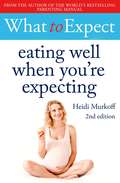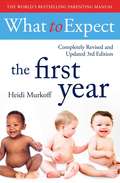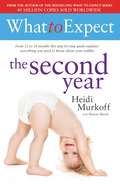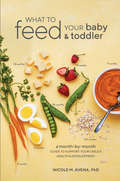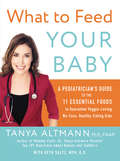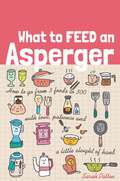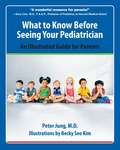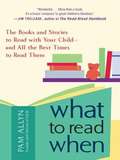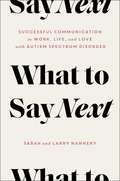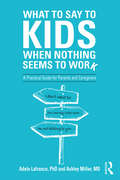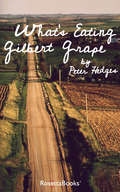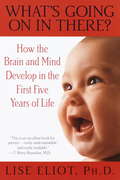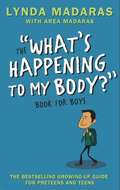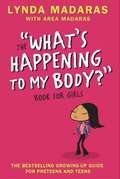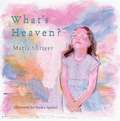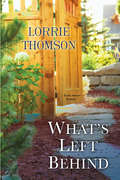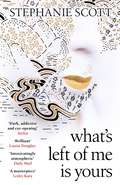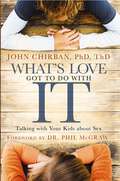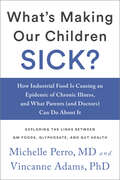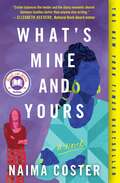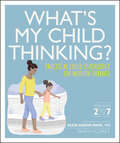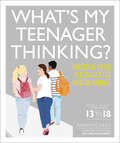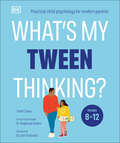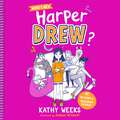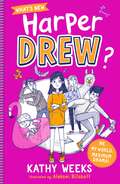- Table View
- List View
What to Expect: Eating Well When You're Expecting 2nd Edition (What To Expect Ser.)
by Heidi MurkoffEating Well When You're Expecting provides mums-to-be with a realistic approach to navigating healthily and deliciously through the nine months of pregnancy - at home, in the office, at Christmas, in restaurants. Thorough chapters are devoted to nutrition, weight gain, food safety, the postpartum diet, and how to eat when trying to conceive again. And the book comes with 150 contemporary, tasty and healthy recipes that feed mum and baby well, take little time to prepare and are gentle on queasy tummies. At the heart of the book are hundreds of pressing questions every mother-to-be has: Is it true I shouldn't eat any food cooked with alcohol? Will the caffeine in coffee cross into my baby's bloodstream? I'm entering my second trimester, and I'm losing weight, not gaining - help! Is all sushi off limits? How do I get enough calcium if I'm lactose intolerant? I keep dreaming about a hot fudge sundae - can I indulge? (The answer is yes!)
What to Expect: The First Year (Third Edition) (What to Expect)
by Heidi Murkoff Sharon Mazel<p>This comprehensive and practical month-by-month guide clearly explains everything parents need to know – or might be worrying about – in the first year with a new baby. <p>Including:-All-new chapter on buying for baby; helping parents navigate through the dizzying gamut of baby products, nursery items and gear. Baby care fundamentals, from crib and sleep safety to vitamin supplements. Feeding for every age and stage, including tips on breastfeeding, preparing homemade baby food and the latest recommendations on starting solids. Charts for key development stages and sleeping habits, as well as sleep strategies that really work. Research on the impact of screen time (TVs, tablets, apps, computers). The most up-to-date medical advice on vaccines, illnesses, SIDS, safety, and more, plus handy first-aid guides. Dozens of Q&A sections, practical tips and advice that focus on advice for parents and their baby, covering everything from how to give a bath and decode your baby's crying to when to return to work. This is the only book on infant care to address both the physical and emotional needs of the whole family. <p>This edition is organised more intuitively than ever before. Covering the most up-to-date knowledge, both medical and developmental, WHAT TO EXPECT THE 1st YEAR is, above all, down-to-earth and reassuring – and an invaluable aid for all parents of new babies. </p>
What to Expect: The Second Year
by Heidi MurkoffThe international super-successful What to Expect brand has delivered again - announcing the arrival of a brand-new member of family: What to Expect the Second Year. This essential sequel to What to Expect the First Year picks up the action at baby's first birthday, and takes parents through what can only be called 'the wonder year' - 12 jam-packed (and jam-smeared) months of memorable milestones (from first steps to first words, first scribbles to first friends), lightning-speed learning, endless explorations driven by insatiable curiosity. Not to mention a year of challenges, both for toddlers and the parents who love them, but don't always love their behaviour (picky eating, negativity, separation anxiety, bedtime battles, biting, and tantrums). Comprehensive, reassuring, empathetic, realistic and practical, What to Expect the Second Year is filled with solutions, strategies, and plenty of parental pep talks. It helps parents decode the fascinating, complicated, sometimes maddening, always adorable little person last year's baby has become. From the first birthday to the second, this must-have book covers everything parents need to know in an easy-to-access, topic-by-topic format, with chapters on growth, feeding, sleeping, behaviours of every conceivable kind, discipline (including teaching right from wrong), and keeping a toddler healthy and safe as he or she takes on the world. There's a developmental time line of the second year plus special 'milestone' boxes throughout that help parents keep track of their toddler's development. Thinking of travelling with tot in tow? There's a chapter for that, too.
What to Feed Your Baby and Toddler: A Month-by-Month Guide to Support Your Child's Health and Development
by Nicole M. AvenaA science-based manual for feeding babies exactly what they need to hit physical and intellectual milestones from 6 to 24 months, with 60 recipes.World-renowned research neuroscientist, nutrition expert, and author of What to Eat When You're Pregnant Dr. Nicole M. Avena presents an essential guide for new parents on feeding babies during their critical first two years. Answering common questions about picky eaters, food allergies, diversifying baby's appetite, eating out or on the go, feeding baby at daycare or when with another caregiver, and food safety, this comprehensive guide offers easy monthly meal plans and baby-friendly, nutrient-rich recipes designed to support your baby's developmental milestones.
What to Feed Your Baby: A Pediatrician's Guide to the Eleven Essential Foods to Guarantee Veggie-Loving, No-Fuss, Healthy-Eating Kids
by Tanya Altmann Beth SaltzAs a pediatrician, spokesperson for the American Academy of Pediatrics, and mother of three boys, Dr. Tanya Altmann knows that good nutrition is essential for healthy kids. In What to Feed Your Baby, Dr. Tanya provides the latest nutritional recommendations and best practices for feeding babies and young children. The simple, fool-proof program focuses on serving eleven foundation foods: eggs, prunes, avocado, fish, yogurt/cheese/milk, nuts, chicken/beans, fruit, green veggies, whole grains, and water. What to Feed Your Baby helps parents set their children up for a lifetime of healthy choices—and say goodbye to picky eating forever!
What to Feed an Asperger: How to go from 3 foods to 300 with love, patience and a little sleight of hand
by Sarah PattenPacked full of tips and tricks to improve the diet of super sensitive Asperger kids, this book is a must read for parents who want to help their children overcome food avoidance and sensory sensitivities. Sarah Patten shows other parents that they are far from alone in their struggle to get their children to eat a varied and well-balanced diet. She describes how, through a combination of love, patience and a little sleight of hand, she managed to get her son to go from eating just three bland white foods to eating a colourful and nutritious diet including fruit and vegetables. Providing recipes for many simple, healthy meals given the Asperger seal of approval, as well as advice for making mealtime routines, eating together as a family and eating out as stress-free as possible, the book provides a wealth of ideas and strategies for moving towards a more varied and nutritious diet. It also includes food diaries and charts to make planning meals and tracking progress simple.
What to Know Before Seeing Your Pediatrician: An Illustrated Guide for Parents
by Becky Kim Peter JungWhat to Know Before Seeing Your Pediatrician is an illustrative guide to educate parents on common pediatric topics to help reduce anxiety and prevent unnecessary visits to the doctor.Written by a board certified pediatrician, What to Know Before Seeing Your Pediatrician covers the basic information that all parents should be aware of prior to taking their children to see a pediatrician.The book includes simple guidance and color illustrations on key topics including the common cold, fever, vomiting and diarrhea, vaccines, ear and sinus infections, bronchitis, laryngitis, and many more.
What to Read When
by Pam AllynRead Pam Allyn's posts on the Penguin Blog The books to read aloud to children at the important moments in their lives. In What to Read When, award-winning educator Pam Allyn celebrates the power of reading aloud with children. In many ways, books provide the first opportunity for children to begin to reflectively engage with and understand the world around them. Not only can parents entertain their child and convey the beauty of language through books, they can also share their values and create lasting connections. Here, Allyn offers parents and caregivers essential advice on choosing appropriate titles for their children--taking into account a child's age, attention ability, gender, and interests-- along with techniques for reading aloud effectively. But what sets this book apart is the extraordinary, annotated list of more than three hundred titles suitable for the pivotal moments in a child's life. With category themes ranging from friendship and journeys to thankfulness, separations, silliness, and spirituality, What to Read When is a one-of-a-kind guide to how parents can best inspire children through reading together. In addition, Pam Allyn includes an indispensable "Reader's Ladder" section, with recommendations for children at every stage from birth to age ten. With the author's warm and engaging voice throughout, discussion questions to encourage in-depth conversations, as well as advice on helping kids make the transition to independent reading, this book will help shape thoughtful, creative, and curious children, imparting a love of reading that will last a lifetime. These Penguin Young Reader's Books are referenced in What to Read When Sylvia Jean: Drama Queen by Lisa Campbell Ernst (Penguin Young Reader's Group: 2005) Two Is For Twins, by Wendy Cheyette Lewison, illustrations by Hiroe Nakata (Penguin Young Readers: 2006) Remember Grandma? by Laura Langston (Penguin Group (USA): May 2004) Soul Looks Back in Wonder compiled by Tom Feelings (Puffin Books) Time of Wonder by Robert McCloskey (Penguin Books USA, Incorporated: December 1957) When I was Young in the Mountainsby Cynthia Rylant illustrated by Diane Goode (Penguin Young Readers Group: January 1993) Nana Upstairs and Nana Downstairs by Tomie DePaola (Puffin Books, an imprint of Penguin Books, Inc.:1973) Good Night, Good Knight by Shelly Moore Thomas, illustrations by Jennifer Plecas (Penguin Young Readers Group: 2002)
What to Say Next: Successful Communication in Work, Life, and Love—with Autism Spectrum Disorder
by Sarah Nannery Larry NanneryUsing her personal experience living as a professional woman with Autism Spectrum Disorder, Sarah Nannery, together with her husband, Larry, offers this timely communication guide for anyone on the Autism spectrum looking to successfully navigate work, life, and love. When Sarah Nannery got her first job at a small nonprofit, she thought she knew exactly what it would take to advance. But soon she realized that even with hard work and conscientiousness, she was missing key meanings and messages embedded in her colleagues&’ everyday requests, feedback, and praise. She had long realized her brain operated differently than others, but now she knew for sure: she had Autism Spectrum Disorder (ASD). With help from her neurotypical partner—now husband—Larry, mostly in frantic IM chats, Sarah rose to Director of Development at one of the world&’s largest nonprofits. Together they have tackled challenges in how Sarah navigates personal and professional relationships, how they navigate marriage and parenthood, all of which are differently challenging for someone with ASD. But she wonders, at times, how life would be different if she&’d had to figure it all out herself. So, in What to Say Next, she offers advice, empathy, and straightforward strategies from her own tool-kit—not only for others who see the world differently, but for their families, partners and colleagues. In What to Say Next, Sarah breaks down everyday situations—the chat in the break room, the last-minute meeting, the unexpected run-in—in granular detail, explaining not only how to understand the goals of others, but also how to frame your own. Larry adds his thoughts from a neurotypical perspective, sharing what was going on in his brain and how he learned to listen and enlighten, while supporting and maintaining Sarah&’s voice. At a time when more and more people are being diagnosed with ASD—especially women and girls—this book tells important truths about what it takes to make it in a neurotypical world, and still be true to yourself.
What to Say to Kids When Nothing Seems to Work: A Practical Guide for Parents and Caregivers
by Ashley Miller Adele LafranceWhat to Say to Kids When Nothing Seems to Work offers parents an effective, step-by-step guide to some of the most common struggles for kids aged 5–12. Written by mental health professionals with over 30 years’ experience listening to kids’ thoughts and feelings, this book provides a framework to explore new ways of responding to your child that will help them calm down faster and boost their resilience to stress. With a dose of humor and plenty of real-life examples, the authors will guide you to "build a bridge" into your child’s world to make sense of their emotions and behavior. Sample scenarios and scripts are provided for you to customize based on your caregiving style and your child’s personality. These are then followed by concrete support strategies to help you manage current and future situations in a way that leaves everyone feeling better. Chapters are organized by common kid-related issues so you can quickly find what’s relevant to you. Suitable for parents, grandparents, and other caregivers of children and pre-teens, as well as professionals working closely with families, What to Say to Kids When Nothing Seems to Work is an accessible resource for efficiently navigating the twists, turns, and sometimes total chaos of life with kids.
What's Eating Gilbert Grape
by Peter Hedges&“Wonderfully entertaining . . . This distinctive first novel goes down like a chocolate milkshake but boasts the sharpness and finesse of a complex wine&” (Publishers Weekly). Gilbert Grape is a twenty-four-year-old grocery store clerk stuck in Endora, Iowa, where the population is 1,091 and shrinking. After the suicide of Gilbert&’s father, his family never fully recovered. Once the town beauty queen, Gilbert&’s mother is now morbidly obese and planted eternally in front of the TV; his younger sister has recently turned both boy-crazy and God-fearing, while his older sister sacrifices everything for her family. And then there&’s Arnie, Gilbert&’s younger brother with special needs. With no one else to care for Arnie, Gilbert becomes his brother&’s main parent, and all four siblings must tend to the needs of their helpless, grieving mother. So Gilbert is in a rut—until a mysterious new girl named Becky arrives in this small town. As his family gathers for Arnie&’s eighteenth birthday, Gilbert finds himself at a crossroads . . . This &“completely original&” portrait of a family (The New York Times), &“charged with sardonic intelligence&” (The Washington Post Book World), was the basis for a film starring Johnny Depp and Leonardo DiCaprio, and stands as one of the most memorable novels of recent decades. &“Sometimes funny, sometimes sad . . . and always engaging.&” —The Atlantic &“By the book&’s exhilaratingly luminous ending . . . we have already been mesmerized.&” —The Philadelphia Inquirer &“A funny, touching, caring first novel whose characters are familiar and moving in spite of (or perhaps because of) their peculiarities.&” —Booklist
What's Going On In There?: How the Brain and Mind Develop in the First Five Years of Life
by Lise EliotAs a research neuroscientist, Lise Eliot has made the study of the human brain her life's work. But it wasn't until she was pregnant with her first child that she became intrigued with the study of brain development. She wanted to know precisely how the baby's brain is formed, and when and how each sense, skill, and cognitive ability is developed. And just as important, she was interested in finding out how her role as a nurturer can affect this complex process. How much of her baby's development is genetically ordained--and how much is determined by environment? Is there anything parents can do to make their babies' brains work better--to help them become smarter, happier people? Drawing upon the exploding research in this field as well as the stories of real children,What's Going On in There'is a lively and thought-provoking book that charts the brain's development from conception through the critical first five years. In examining the many factors that play crucial roles in that process,What's Going On in There'explores the evolution of the senses, motor skills, social and emotional behaviors, and mental functions such as attention, language, memory, reasoning, and intelligence. This remarkable book also discusses: how a baby's brain is "assembled" from scratch the critical prenatal factors that shapebrain development how the birthing process itself affects the brain which forms of stimulation are most effective at promoting cognitive development how boys' and girls' brains develop differently how nutrition, stress, and other physical and social factors can permanently affect a child's brain Brilliantly blending cutting-edge science with a mother's wisdom and insight,What's Going On in There'is an invaluable contribution to the nature versus nurture debate. Children's development is determined both by the genes they are born with and the richness of their early environment. This timely and important book shows parents the innumerable ways in which they can actually help their children grow better brains.
What's Happening to My Body? Book for Boys: Revised Edition (What's Happening to My Body?)
by Lynda Madaras Simon Sullivan Area MadarasEverything preteen and teen boys need to know about their changing bodies and feelings. Written by an experienced educator and her daughter in a reassuring and down-to earth style, The "What's Happening to My Body?" Book for Boys gives sensitive straight talk on: the body's changing size and shape; diet and exercise; the growth spurt; the reproductive organs; body hair; voice changes; romantic and sexual feelings; and puberty in the opposite sex. It also includes information on steroid abuse, acne treatment, sexually transmitted diseases, AIDS, and birth control. Featuring detailed illustrations and real-life stories throughout, plus an introduction for parents and a helpful resource section, this bestselling growing-up guide is an essential puberty education and health book for all boys ages 10 and up.
What's Happening to My Body? Book for Girls
by Lynda Madaras Simon Sullivan Area MadarasEverything preteen and teen girls need to know about their changing bodies and feelings Written by an experienced educator and her daughter in a reassuring and down-to-earth style, The "What's Happening to My Body?" Book for Girls gives sensitive straight talk on: the body's changing size and shape; the growth spurt; breast development; the reproductive organs; the menstrual cycle; body hair; diet and exercise; romantic and sexual feelings; and puberty in the opposite sex. It also includes information on anorexia and bulimia, sexually transmitted diseases, AIDS, and birth control. Featuring detailed illustrations and real-life stories throughout, plus an introduction for parents and a helpful resource section, this bestselling growing-up guide is an essential puberty education and health book for all girls ages 10 and up. Selected as a Best Book for Young Adults by the American Library Association.
What's Heaven?
by Maria ShriverWhat's Heaven is the story of Kate, a little girl whose great-grandma has just died. She seeks answers, and her mother helps her learn about Heaven. The many questions in this book--childlike and thought-provoking--are real, coming from Maria Shriver's own children, nieces and nephews when her grandmother Rose Fitzgerald Kennedy passed away. With loving, confident, and ultimately uplifting answers, Shriver taught her family, and will teach yours, how to come together, feel closer to each other, and feel peace. Picture descriptions added.
What's Left Behind
by Lorrie ThomsonWhen the person you've built your whole life around is gone, what do you do? It's not the first time Abby Stone has faced the question. At eighteen, she envisioned a future with her childhood sweetheart, Charlie, only to have him go off to school and leave a pregnant Abby behind. But that pales beside a second loss, when her eighteen-year-old son, Luke, falls to his death from his third-floor dorm.Abby throws herself into running her thriving B&B on the coast of Maine. With the help of Rob, a local landscape architect, she plans a backyard labyrinth as a memorial to Luke--a place to find peace and solace. Even as Charlie begins hanging around again, looking for a chance to do right by her, Abby resolves to look forward, not back. And then Luke's girlfriend arrives on Abby's doorstep--pregnant, as alone as Abby once was--bringing with her the unexpected gift of a new beginning, one that celebrates the past. Rich in emotion and insight, this beautifully written novel explores the depth of a mother's bond, resilience after unimaginable loss, and the way love's memory can fill the gaps in a shattered heart. Praise for Lorrie Thomson's Equilibrium"An emotional, complex, and deeply satisfying novel about the power of hope, love, and family. I couldn't put it down!" --Lisa Verge Higgins"Tender, heartbreaking and beautifully realistic. Fans of Anita Shreve will be riveted by this intense and compassionate story." --Hank Phillippi Ryan, Agatha, Anthony and Macavity-winning author"Fans of Kristin Hannah and Holly Chamberlin will similarly appreciate this hopeful, uplifting story." --Booklist"Thomson's debut is riveting." --RT Book Reviews
What's Left of Me is Yours
by Stephanie ScottA BOOK OF THE YEAR FOR THE DAILY MAIL AND WOMAN AND HOMEA New York Times 'Editor's Pick'One of the Observer's Ten Best Debut Novelists of 2020Shortlisted for the Author's Club First Novel AwardLonglisted for the Jhalak PrizeLonglisted for the CWA John Creasy New Blood Dagger'Enrapturing... This richly imagined novel considers the many permutations of love and what we are capable of doing in its name' New York Times'A brilliant debut' Louise Doughty, author of Apple Tree Yard'You'll have the heart rate of an Olympic hurdler' Sunday Express'I read it with my heart in my throat' Sara Collins, author of The Confessions of Frannie Langton 'An exquisitely crafted masterpiece you'll be pressing into the hands of others' Woman & Home 'An intoxicatingly atmospheric mystery' Daily Mail'Dark, addictive and eye-opening, this is a brilliant debut' StylistA gripping debut set in modern-day Tokyo and inspired by a true crime, What's Left of Me Is Yours follows a young woman's search for the truth about her mother's life - and her murder.In Japan, a covert industry has grown up around the wakaresaseya (literally "breaker-upper"), a person hired by one spouse to seduce the other in order to gain the advantage in divorce proceedings.When Sato hires Kaitaro, a wakaresaseya agent, to have an affair with his wife, Rina, he assumes it will be an easy case. But Sato has never truly understood Rina or her desires and Kaitaro's job is to do exactly that - until he does it too well.While Rina remains ignorant of the circumstances that brought them together, she and Kaitaro fall in a desperate, singular love, setting in motion a series of violent acts that will forever haunt her daughter Sumiko's life.Told from alternating points of view and across the breathtaking landscapes of Japan, What's Left of Me Is Yours explores the thorny psychological and moral grounds of the actions we take in the name of love, asking where we draw the line between passion and possession.
What's Love Got to Do With It: Talking With Your Kids About Sex
by John ChirbanHaving trouble talking to your kids about sex? Their friends at school don't... Unfortunately, for many parents, the most important conversations are the hardest. Ninety-three percent of adults are dissatisfied with the sex education they received as children, which is precisely why they are so bad at teaching their kids-they have no frame of reference. Renowned Harvard Medical School psychologist and frequent Dr. Phil guest John Chirban helps parents talk to their kids . . . about sex. Kids are going to learn about sex, and it is up to parents to decide if their kids are going to learn from them or from MTV. How parents address sex--their openness, the context, and their attitudes--will impact how their children view their own sexuality and self worth. Dr. Chirban helps parents know when, how, and how much. He uses humor, compassion, and real-life examples to prepare parents for a healthy and ongoing conversation that will equip their kids to own their own sexuality and an understanding of the larger issues of relationships, love, commitment, and intimacy. In addition, parents understand how helping their children understand these veiled yet critical keys of a fulfilling life deepens their own connection with their children.
What's Making Our Children Sick?: How Industrial Food Is Causing an Epidemic of Chronic Illness, and What Parents (and Doctors) Can Do About It
by Michelle Perro Vincanne AdamsExploring the links between GM foods, glyphosate, and gut healthWith chronic disorders among American children reaching epidemic levels, hundreds of thousands of parents are desperately seeking solutions to their children&’s declining health, often with little medical guidance from the experts. What&’s Making Our Children Sick? convincingly explains how agrochemical industrial production and genetic modification of foods is a culprit in this epidemic. Is it the only culprit? No. Most chronic health disorders have multiple causes and require careful disentanglement and complex treatments. But what if toxicants in our foods are a major culprit, one that, if corrected, could lead to tangible results and increased health? Using patient accounts of their clinical experiences and new medical insights about pathogenesis of chronic pediatric disorders—taking us into gut dysfunction and the microbiome, as well as the politics of food science—this book connects the dots to explain our kids&’ ailing health.What&’s Making Our Children Sick? explores the frightening links between our efforts to create higher-yield, cost-efficient foods and an explosion of childhood morbidity, but it also offers hope and a path to effecting change. The predicament we now face is simple. Agroindustrial &“innovation&” in a previous era hoped to prevent the ecosystem disaster of DDT predicted in Rachel Carson&’s seminal book in 1962, Silent Spring. However, this industrial agriculture movement has created a worse disaster: a toxic environment and, consequently, a toxic food supply. Pesticide use is at an all-time high, despite the fact that biotechnologies aimed to reduce the need for them in the first place. Today these chemicals find their way into our livestock and food crop industries and ultimately onto our plates. Many of these pesticides are the modern day equivalent of DDT. However, scant research exists on the chemical soup of poisons that our children consume on a daily basis. As our food supply environment reels under the pressures of industrialization via agrochemicals, our kids have become the walking evidence of this failed experiment. What&’s Making Our Children Sick? exposes our current predicament and offers insight on the medical responses that are available, both to heal our kids and to reverse the compromised health of our food supply.&“Perro and Adams&’ book is an alarming, eye-opening read that documents more clearly than ever the devastating consequences that pervasive pesticide use in food production is having on our health, and the urgent need to protect our children from a system that prefers we treat illness and disease with pills rather than prevention.&”—Carey Gillam, journalist, author of Whitewash
What's Mine and Yours
by Naima CosterA Read with Jenna Today Show Book Club Pick!An instant New York Times bestseller!"A once-every-few-years reading experience."—Mary Beth Keane, New York Times bestselling author of Ask Again, Yes"Coster portrays her characters&’ worlds with startling vitality. As the children fall in lust and love, grapple with angst and battle the tides of New South politics, Coster&’s writing shines"—New York Times Book ReviewFrom the author of Halsey Street, a sweeping novel of legacy, identity, the American family—and the ways that race affects even our most intimate relationships.A community in the Piedmont of North Carolina rises in outrage as a county initiative draws students from the largely Black east side of town into predominantly white high schools on the west. For two students, Gee and Noelle, the integration sets off a chain of events that will tie their two families together in unexpected ways over the next twenty years.On one side of the integration debate is Jade, Gee's steely, ambitious mother. In the aftermath of a harrowing loss, she is determined to give her son the tools he'll need to survive in America as a sensitive, anxious, young Black man. On the other side is Noelle's headstrong mother, Lacey May, a white woman who refuses to see her half-Latina daughters as anything but white. She strives to protect them as she couldn't protect herself from the influence of their charming but unreliable father, Robbie.When Gee and Noelle join the school play meant to bridge the divide between new and old students, their paths collide, and their two seemingly disconnected families begin to form deeply knotted, messy ties that will shape the trajectory of their adult lives. And their mothers—each determined to see her child inherit a better life—will make choices that will haunt them for decades to come.As love is built and lost, and the past never too far behind, What's Mine and Yours is an expansive, vibrant tapestry that moves between the years, from the foothills of North Carolina, to Atlanta, Los Angeles, and Paris. It explores the unique organism that is every family: what breaks them apart and how they come back together.
What's My Child Thinking?: Practical Child Psychology for Modern Parents
by Eileen Kennedy-Moore Tanith CareyMake every moment with your child count. Tap into the psychology behind your child's behavior at every stage of development, and respond with confidence.Find out what your child really means when he says "Look what I did", "But I'm not tired," or "You're embarrassing me," and discover what's really going on when he can't express himself at all.Using more than 100 everyday scenarios, the book leads you through each one step by step, explaining not only your child's behavior and the psychology behind it but also your own feelings as a parent. It then gives instant recommendations for what you could say and do in response to best resolve the situation.Covering all your child's developmental milestones from ages 2 to 7 years, What's My Child Thinking? covers important issues, such as temper tantrums, friendships (real and imaginary), sibling rivalry, aggressive behavior, and peer pressure. There's also a bank of practical "survival guides" for critical times, such as traveling in the car, eating out, and going online safely. Rooted in evidence-based clinical psychology and championing positive parenting, What's My Child Thinking? will help you tune in to your child's innermost thoughts and be the parent you want to be.
What's My Teenager Thinking: Practical Child Psychology for Modern Parents
by Tanith CareyAs the teenage brain rewires, hormones surge, and independence beckons, a perfect storm for family conflict emerges. Parenting just got tougher. But help is at hand.This uniquely practical parenting book for raising teenagers in today's world explores the science at work during this period of development, translates teenage behavior, and shows you how you can best respond as a parent - in the moment and the long term.Taking over 100 everyday scenarios, the book tackles real-world situations head-on - from what to do when your teenager slams their bedroom door in your face to how to handle worries about online safety, peer group pressure, school work, and sex.Discover how to create a supportive environment and communicate with confidence - to help your teenager manage whatever life brings.
What's My Tween Thinking?: Practical Child Psychology for Modern Parents
by Tanith CareyParenting just got tougher. As your child&’s brain rewires, hormones kick in, and independence beckons, a perfect storm for family conflict emerges. But help is at hand.Divided into two sections – aged 8 to 10 and aged 10 to 12 – this practical parenting book is grounded in evidence-based psychology, exploring the science at work during this period of your child&’s development.Taking 75 everyday scenarios, the book tackles real-world issues head-on, from sibling clashes and sulks to more serious concerns as your child edges towards their teenage years, such as handling anger, body consciousness, online safety, and self-harm.Discover how to create a supportive environment at home and how your behavior can help your tween manage whatever life throws at them as you also explore: -Difficult topics relevant to parents today, such as pornography and self-harm.-Everyday topics include clashes over sleepovers, first phones, homework, and going out with friends.-Content by Dr Angharad Rudkin, who is a child psychology expert, and Tanith Carey, a well-known parenting journalist who writes regularly for the Guardian.Building a strong relationship based on mutual trust and respect will ensure a smooth transition into your child&’s teenage years.
What's New, Harper Drew?: Book 1 (What's New, Harper Drew? #1)
by Kathy WeeksWelcome to the hilarious WORLD of Harper Drew... there's a whole lot of DRAMA, but luckily she has tried and tested methods to deal with it! Perfect for fans of Dork Diaries.My name is Harper Drew. I'm using my new journal to take note of all the totally ridiculous things that seem to go on around me with my family and friends. I seem to be the ONLY ONE who sees all of this stuff for what it is. Completely BEYOND normal.Recently I've been logging Drew Dial Ratings for all the mayhem. On a scale of 0 to 10, how likely is someone to SAY or DO something that would be less sensible than (for example) ... a demented camel? First up is the annual Drew trip to France... and while there might not be camels, there are BATS and Llamas - and my brother Troy who is so obsessed with his hairstyle, he won't even go swimming... that's a whole lot of ratings. I'm just hoping I land an invite to Maisie Felix's party when I'm back to distract me from the Drews... for one whole evening!The start of a relatable new audiobook series, all about embracing your family, and finding unique ways to deal with life's dramas.(P) 2022 Hodder & Stoughton Limited
What's New, Harper Drew?: Book 1 (What's New, Harper Drew?)
by Kathy WeeksWelcome to the hilarious WORLD of Harper Drew... there's a whole lot of DRAMA, but luckily she has tried and tested methods to deal with it! Perfect for fans of Dork Diaries.My name is Harper Drew. I'm using my new journal to take note of all the totally ridiculous things that seem to go on around me with my family and friends. I seem to be the ONLY ONE who sees this all of this stuff for what it is. Completely BEYOND normal.Recently I've been logging Drew Dial Ratings for all the mayhem. On a scale of 0 to 10, how likely is someone to SAY or DO something that would be less sensible than (for example) ... a demented camel? First up is the annual Drew trip to France... and while there might not be camels, there are BATS and Llamas - and my brother Troy who is so obsessed with his hairstyle, he won't even go swimming... that's a whole lot of ratings. I'm just hoping I land an invite to Maisie Felix's party when I'm back to distract me from the Drews... for one whole evening!The start of a relatable new illustrated series, all about embracing your family, and finding unique ways to deal with life's dramas.
